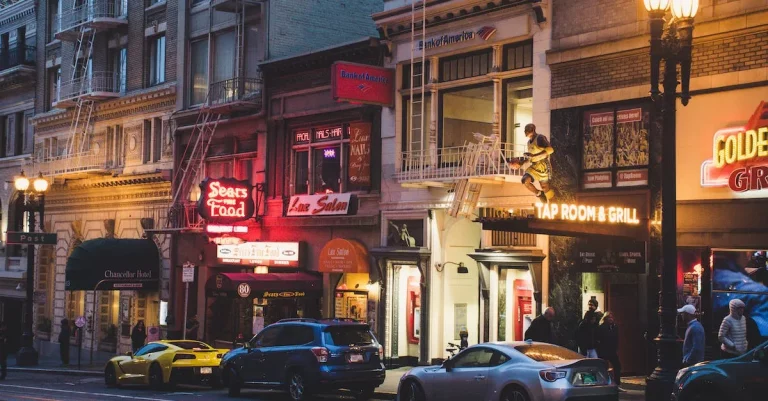Sundown Towns In Texas: Their History And Enduring Impact
Racism and segregation have long shadows, as seen in the enduring legacy of sundown towns in Texas. These all-white communities that historically excluded non-whites may seem like relics of the past, but their influence still reverberates today.
If you’re short on time, here’s a quick answer to your question: Texas had hundreds of sundown towns from the late 1800s through the civil rights era of the 1960s. Though no longer formally in existence, their painful legacy lives on through continued residential segregation and economic inequality.
In this comprehensive guide, we will explore the rise and fall of sundown towns in Texas, looking at how they emerged in the Jim Crow era, how civil rights legislation led to their decline, and how their exclusionary practices continue to shape Texas communities today.
The Origin and Proliferation of Sundown Towns in Texas
Sundown towns, also known as sunset towns, were communities where African Americans and other minority groups were not allowed to reside after dark. These towns became prevalent in Texas during the early 20th century, perpetuating racial segregation and discrimination.
Racial violence, voter suppression, and Jim Crow laws after Reconstruction
Following the Reconstruction era, racial tension and violence were widespread in Texas. African Americans faced systemic discrimination, which included voter suppression and the implementation of Jim Crow laws. These laws enforced racial segregation and further marginalized minority communities.
In this hostile environment, sundown towns emerged as a way to intensify racial exclusion. By denying African Americans the right to live within their boundaries, these towns aimed to maintain white dominance and control over local resources and power structures.
Towns formalized racial exclusion through ordinances and intimidation
Sundown towns in Texas formalized their racial exclusion through local ordinances and intimidation tactics. They enacted laws prohibiting African Americans from residing within city limits, and those found in violation could face harassment, violence, or even expulsion.
White residents often took it upon themselves to enforce these ordinances, using intimidation tactics to discourage African Americans from staying past sundown. This included verbal threats, physical violence, and acts of terrorism, creating an atmosphere of fear that forced minority communities to comply with discriminatory rules.
Sundown towns spread rapidly across Texas in the early 20th century
The proliferation of sundown towns in Texas occurred rapidly in the early 20th century. As the Jim Crow era gained momentum, these towns multiplied, establishing a network of racial exclusion throughout the state.
Communities across Texas embraced sundown town practices, following the lead of larger cities and towns that had already implemented such policies. This rapid spread was facilitated by the prevalent racism of the time, as well as the lack of legal consequences for racial segregation.
Today, the legacy of sundown towns in Texas can still be felt. While many of these towns have officially repealed their exclusionary ordinances, the deep-rooted impact on minority communities persists.
It is essential to acknowledge and learn from this dark chapter in Texas history to ensure a more inclusive and equitable future for all.
Common Practices of Exclusion and Intimidation in Sundown Towns
Strict racial zoning laws and housing discrimination
In sundown towns across Texas, strict racial zoning laws and housing discrimination were common practices that aimed to keep non-white individuals out of these communities. These towns enforced policies that explicitly prohibited non-white residents from owning or renting property, effectively segregating the population along racial lines.
This systemic discrimination not only limited housing options for people of color but also perpetuated racial inequalities and reinforced the social hierarchy of the time.
Public signage and strict curfews for non-white visitors
Another method of exclusion and intimidation used in sundown towns was the implementation of public signage and curfews specifically targeting non-white visitors. Signs were often displayed at town entrances or on main roads, warning people of color that they were not welcome after sundown.
These signs served as a clear message of exclusion and intimidation, effectively creating a hostile environment for non-white individuals.
In addition to signage, strict curfews were enforced to further prevent non-white individuals from entering these towns. These curfews restricted the movement of people of color within the town limits during specific hours, effectively limiting their access to public spaces and services.
Threats, harassment, and racial violence as enforcement
In order to maintain the racial homogeneity of sundown towns, threats, harassment, and racial violence were often used as means of enforcement. African Americans and other minority groups who ventured into these towns after sundown were subject to verbal abuse, physical assault, and even lynching.
These acts of violence were intended to intimidate and instill fear in non-white individuals, ensuring compliance with the unwritten rules of racial exclusion.
The enduring impact of these practices is significant, as they perpetuated racial segregation and contributed to the marginalization of minority communities. While progress has been made in dismantling these discriminatory practices, it is important to acknowledge and address the historical legacy of sundown towns in Texas and their lasting effects on racial inequality.
The Decline of Sundown Towns in the Civil Rights Era
Federal civil rights legislation targeted discriminatory policies
During the Civil Rights Era, the United States experienced a significant shift towards equality and justice. One of the key factors contributing to the decline of sundown towns in Texas was the implementation of federal civil rights legislation.
Laws such as the Civil Rights Act of 1964 and the Fair Housing Act of 1968 aimed to eliminate discriminatory practices and ensure equal treatment for all individuals, regardless of their race.
These legislations played a crucial role in challenging the discriminatory policies that were prevalent in sundown towns. They provided legal recourse for individuals who faced discrimination and empowered them to fight against the injustices they experienced.
Non-violent protests challenged sundown town norms
In addition to federal legislation, non-violent protests also played a significant role in challenging the norms of sundown towns. Inspired by leaders like Martin Luther King Jr. and Rosa Parks, activists organized sit-ins, marches, and boycotts to draw attention to the discriminatory practices in these towns.
These peaceful demonstrations aimed to raise awareness about the systemic racism and encourage dialogue and change. They brought national attention to the issue, forcing communities and lawmakers to confront the injustices happening within their own towns.
Through their determination and bravery, these activists paved the way for a more inclusive and equitable society, helping to dismantle the oppressive structures that allowed sundown towns to thrive.
Supreme court rulings overturned racist ordinances
Supreme Court rulings also played a crucial role in the decline of sundown towns. Landmark cases such as Shelley v. Kraemer in 1948 and Jones v. Mayer in 1968 established that racially restrictive covenants and discriminatory housing practices were unconstitutional.
These rulings invalidated the legal basis for exclusionary practices in sundown towns and set a precedent for dismantling the discriminatory policies that had been ingrained in many communities. They provided a legal framework for challenging the status quo and ensured that individuals could no longer be denied housing opportunities based on their race.
As a result of these Supreme Court decisions, sundown towns faced increasing pressure to dismantle their discriminatory policies and embrace a more inclusive future.
It is important to recognize the efforts of individuals, communities, and the legal system that contributed to the decline of sundown towns in Texas. While their impact lingers in some places, progress has been made towards creating a more equal and inclusive society.
Lasting Impacts: Sundown Towns and Modern Segregation in Texas
Sundown towns, a term used to describe all-white communities that enforced racial segregation through discriminatory practices, have had a lasting impact on Texas and its current state of segregation.
Despite the end of legalized segregation, these patterns of exclusion and discrimination continue to shape residential, demographic, and economic dynamics in the state.
Continued patterns of residential segregation
The legacy of sundown towns is evident in the continued patterns of residential segregation in Texas. Even today, many neighborhoods and communities remain racially homogenous due to historical exclusionary practices.
This segregation limits opportunities for interaction and perpetuates racial divisions.
According to recent studies, Texas still exhibits high levels of residential segregation, particularly between White and Black or Hispanic populations. These patterns are often a result of historical policies and discriminatory practices that have restricted access to housing and resources for minority communities.
Community identity and demographics shaped by exclusionary origins
The origins of sundown towns have shaped the community identity and demographics of many Texas towns and cities. These exclusionary practices have influenced the racial composition of these areas, with lasting effects on cultural diversity and the experiences of people of color.
For instance, certain towns in Texas have gained notoriety for their historical exclusion of racial minorities. The impact of these practices can still be felt today, as the demographics of these towns may remain overwhelmingly White, which can affect the perspectives and experiences of residents from diverse backgrounds.
Economic inequality and opportunity gaps with racial dimensions
The enduring impact of sundown towns is also evident in the economic inequality and opportunity gaps that exist in Texas, often with racial dimensions. The historical exclusion of minority communities from certain areas has limited their access to quality education, employment opportunities, and resources.
Studies have shown that racial disparities in income, wealth, and educational attainment persist in Texas. These disparities can be traced back to the discriminatory practices of sundown towns and their long-lasting effects on economic opportunities for marginalized communities.
Addressing the enduring impacts of sundown towns requires a comprehensive approach that acknowledges historical injustices and actively works towards dismantling the barriers that perpetuate segregation and inequality.
By recognizing the lasting effects of these practices, Texas can strive towards a more inclusive and equitable future for all its residents.
Efforts To Confront the Enduring Racism of Sundown Towns
Sundown towns in Texas have a dark and troubling history rooted in racism and discrimination. These towns, which enforced strict racial segregation after sundown, were prevalent across the state and had a lasting impact on marginalized communities.
However, in recent years, there have been concerted efforts to confront and address the enduring racism of sundown towns.
Public reconciliation and acknowledgement of racist pasts
One important step towards confronting the racism of sundown towns is through public reconciliation and acknowledgement of their racist pasts. Communities and local governments have started to openly discuss and acknowledge the historical injustices that occurred in these towns.
This includes erecting memorials and markers to commemorate the lives affected by racial violence and discrimination. By publicly acknowledging the past, communities can begin the process of healing and moving forward towards a more inclusive future.
Targeted investment and development in marginalized communities
Another crucial aspect of addressing the enduring impact of sundown towns is through targeted investment and development in marginalized communities. Government entities and organizations are working to allocate resources and funding to these communities, aiming to address the systemic inequalities that have persisted for decades.
By investing in infrastructure, education, healthcare, and economic opportunities, marginalized communities can begin to overcome the historical disadvantages imposed upon them.
Grassroots advocacy and education around systemic racism
Grassroots advocacy and education play a pivotal role in confronting the enduring racism of sundown towns. Activists and community organizations are working tirelessly to raise awareness about the history of sundown towns and the ongoing effects of systemic racism.
By organizing protests, workshops, and community dialogues, they are fostering a deeper understanding of the issues and mobilizing support for meaningful change. Education is key to challenging and dismantling the structures that perpetuate racism, and grassroots efforts are instrumental in driving this change.
Efforts to confront the enduring racism of sundown towns are necessary to create a more inclusive and equitable society. By acknowledging the past, investing in marginalized communities, and advocating for systemic change, we can work towards a future where everyone is treated with dignity and equality.
Conclusion
The sundown towns of Texas present a sobering case study in how racism and exclusion can become deeply embedded in communities. Even decades after civil rights legislation seemingly relegated such discriminatory practices to the past, their influence lingers.
By better understanding this painful history and its modern manifestations, Texans of all backgrounds can work together to heal old wounds and build more just, equitable, and inclusive communities for the future.








